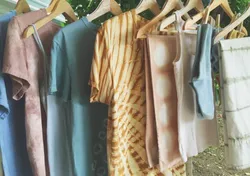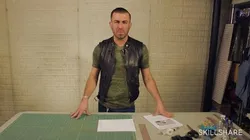
Natural Dyeing: Transform Cloth Using Food Dyes with The Dogwood Dyer 
The Dogwood Dyer will teach participants the time-honored art of natural dyeing using organic plant matter and naturally occurring minerals. Through experimentation, participants will learn how to transform cloth using food dyes and gain a better understanding of the process. ▼
ADVERTISEMENT
Course Feature
![]() Cost:
Cost:
Free Trial
![]() Provider:
Provider:
Skillshare
![]() Certificate:
Certificate:
Paid Certification
![]() Language:
Language:
English
![]() Start Date:
Start Date:
On-Demand
Course Overview
❗The content presented here is sourced directly from Skillshare platform. For comprehensive course details, including enrollment information, simply click on the 'Go to class' link on our website.
Updated in [February 21st, 2023]
(Please note the following content is from the official provider.)
Using only organic plant matter such food waste intended for the compost, and naturally occurring minerals such as iron & aluminum, you will gain knowledge and experiment with the time honored art of natural dyeing.
In this class you will come away with an understanding of how to work with natural colors to achieve the most vibrant and long lasting results while learning about traditional shibori surface design techniques. Liz will lead a tutorial in her professional outdoor dye studio demonstrating some of her favorite low impact dye extraction methods using scraps from common food items.
Most everyone has had to donate or downcycle garments or linens at some point due to everyday wear, spills, accidents and laundry mishaps. Following the dye techniques from this class, you can mask unsightly stains using accessible, kitchen safe dyes. All you need to breathe new life into an old or stained garment for this project is the food of your choice and a few common household tools. No prior knowledge on textiles or dyes is required. This project is for anyone looking to create and experiment with beautiful colors while doing no harm to the planet, your home and your body.
(Please note that we obtained the following content based on information that users may want to know, such as skills, applicable scenarios, future development, etc., combined with AI tools, and have been manually reviewed)
1. Using only organic plant matter such food waste intended for the compost, and naturally occurring minerals such as iron & aluminum, you will gain knowledge and experiment with the time honored art of natural dyeing. In this class you will come away with an understanding of how to work with natural colors to achieve the most vibrant and long lasting results while learning about traditional shibori surface design techniques. Liz will lead a tutorial in her professional outdoor dye studio demonstrating some of her favorite low impact dye extraction methods using scraps from common food items.
2. In this course, users will learn the time-honored art of natural dyeing, and gain knowledge on how to work with natural colors to achieve the most vibrant and long lasting results. They will also learn about traditional shibori surface design techniques and low impact dye extraction methods using scraps from common food items. This course is suitable for anyone looking to create and experiment with beautiful colors while doing no harm to the planet, their home and their body.
3. This course provides users with an understanding of the time-honored art of natural dyeing, and how to work with natural colors to achieve the most vibrant and long lasting results. Possible Development Directions: Users will learn about traditional shibori surface design techniques and low impact dye extraction methods using scraps from common food items. Related Learning Suggestions: This course is suitable for anyone looking to create and experiment with beautiful colors while doing no harm to the planet, their home and their body.
4. Natural dyeing is an ancient art that has been used for centuries to create beautiful and vibrant colors. In this course, users will learn how to use organic plant matter and naturally occurring minerals to create stunning colors. They will also learn about traditional shibori surface design techniques and low impact dye extraction methods using scraps from common food items. This course is perfect for anyone looking to create and experiment with beautiful colors while doing no harm to the planet, their home and their body. With the knowledge and skills gained from this course, users will be able to breathe new life into old or stained garments, and create stunning pieces of art.
[Applications]
Those who have taken this course on Natural Dyeing: Transform Cloth Using Food Dyes with The Dogwood Dyer will have gained knowledge and experimented with the time honored art of natural dyeing. They will have come away with an understanding of how to work with natural colors to achieve the most vibrant and long lasting results while learning about traditional shibori surface design techniques. They will also have learned how to mask unsightly stains using accessible, kitchen safe dyes. With this knowledge, they can apply it to breathe new life into old or stained garments, and create and experiment with beautiful colors while doing no harm to the planet, their home and their body.
[Career Paths]
1. Natural Dyeing Technician: Natural dyeing technicians are responsible for creating and maintaining natural dyes for fabrics and other materials. They must have a strong knowledge of the various natural dyeing techniques and be able to identify and use the right materials for the job. They must also be able to work with a variety of fabrics and materials, as well as understand the different types of dyes and their effects on the fabric. This job is growing in popularity as more people are looking for sustainable and eco-friendly ways to dye fabrics.
2. Textile Designer: Textile designers are responsible for creating and designing fabrics and other materials for clothing, home decor, and other products. They must have a strong knowledge of the various natural dyeing techniques and be able to identify and use the right materials for the job. They must also be able to work with a variety of fabrics and materials, as well as understand the different types of dyes and their effects on the fabric. This job is growing in popularity as more people are looking for sustainable and eco-friendly ways to create unique and beautiful fabrics.
3. Natural Dyeing Educator: Natural dyeing educators are responsible for teaching and educating others on the various natural dyeing techniques. They must have a strong knowledge of the various natural dyeing techniques and be able to identify and use the right materials for the job. They must also be able to work with a variety of fabrics and materials, as well as understand the different types of dyes and their effects on the fabric. This job is growing in popularity as more people are looking for sustainable and eco-friendly ways to dye fabrics.
4. Natural Dyeing Consultant: Natural dyeing consultants are responsible for providing advice and guidance to clients on the various natural dyeing techniques. They must have a strong knowledge of the various natural dyeing techniques and be able to identify and use the right materials for the job. They must also be able to work with a variety of fabrics and materials, as well as understand the different types of dyes and their effects on the fabric. This job is growing in popularity as more people are looking for sustainable and eco-friendly ways to dye fabrics.
[Education Paths]
1. Textile Design: Textile design is a degree path that focuses on the design and production of fabrics and other textiles. It involves the use of color, pattern, texture, and other elements to create unique and visually appealing fabrics. This degree path is becoming increasingly popular as more people are looking for sustainable and eco-friendly options for their clothing and home decor. Students in this degree path will learn about the history of textiles, the different types of fabrics, and the various techniques used to create them. They will also learn about the different dyeing techniques, such as natural dyeing, and how to use them to create beautiful and unique fabrics.
2. Sustainable Fashion: Sustainable fashion is a degree path that focuses on the production of clothing and accessories in an environmentally friendly and socially responsible way. Students in this degree path will learn about the different materials used in fashion, the different production processes, and the various ways to reduce the environmental impact of fashion production. They will also learn about the different dyeing techniques, such as natural dyeing, and how to use them to create beautiful and unique fabrics.
3. Art and Design: Art and design is a degree path that focuses on the creation of art and design pieces. Students in this degree path will learn about the different materials used in art and design, the different production processes, and the various ways to create unique and visually appealing pieces. They will also learn about the different dyeing techniques, such as natural dyeing, and how to use them to create beautiful and unique fabrics.
4. Environmental Science: Environmental science is a degree path that focuses on the study of the environment and its impact on human health and the environment. Students in this degree path will learn about the different environmental issues, the different ways to reduce the environmental impact of production processes, and the various ways to create sustainable and eco-friendly products. They will also learn about the different dyeing techniques, such as natural dyeing, and how to use them to create beautiful and unique fabrics.
Pros & Cons

Engaging teacher.

Fascinating portfolio.

Simple to follow.

Long texts with small type.

Difficult to digest.

Wide spectrum to understand.
Course Provider

Provider Skillshare's Stats at AZClass
Discussion and Reviews
0.0 (Based on 0 reviews)
Explore Similar Online Courses

AutoCAD Basic Commands for Beginners with practical Approach

Creating ServiceNow Knowledge Bases

Python for Informatics: Exploring Information

Social Network Analysis

Introduction to Systematic Review and Meta-Analysis

The Analytics Edge

DCO042 - Python For Informatics

Causal Diagrams: Draw Your Assumptions Before Your Conclusions

Whole genome sequencing of bacterial genomes - tools and applications

Make Your Own Clothing: Introduction to Garment Construction

Gaultier to Louboutin: Style & Strategy in French Fashion


Start your review of Natural Dyeing: Transform Cloth Using Food Dyes with The Dogwood Dyer